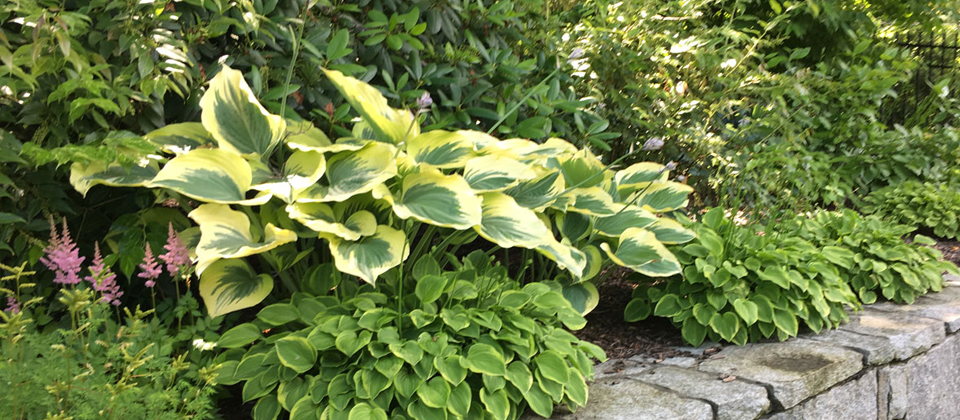Blog, Garden Blog, Garden Tips, News and Tips
Shade Plants Put on a Show!
Shade plants offer much more color and variety than most of us imagine. Your best bet is to stick with plants that note full or part shade. We find good definitions to be 0-2 hours of sun for shade and 2-4 for part shade, and like some light and bright tones to punctuate shade.
Almost all spring bulbs work in areas around trees, since they will bloom before the tree leafs out.
For lots of color in shade plants through the season, consider bright annual Impatiens. They’re especially great in two or three rows to create a vivid band of color on the front border. Begonias love shade, too.
Variegated Leaf Shade Plants
A great way to achieve long color in shade gardens is plants with variegated leaves. Mix in some Hostas with large areas of white in their leaves – there are some lovely limes, too. A large blue-green elegans is beloved as a great focal point. Other bright leaves include some ferns, especially the Japanese varieties. The delicacy of ferns’ leaves add beauty in shade plants, and Solomon Seal fills and spreads nicely (great with Dicentra, which dies back in heat). There are probably more varieties than you know – do some searching. One grass, Hakonechloa macra aureola, in gold, grows in shade, as does variegated Lamium and Brunnera with striking leaves and small blue flowers. Caladiums are always stunning – try them with dragon-wing begonia for drama –and most Coleus prefer part-shade.
Spring and Summer Shade Plants that Flower
In the spring, Dicentra, pink or white bleeding heart, tiny flowers on arching stems, are gorgeous and seed freely. Primroses may bloom all summer in cooler areas, and do a spring and fall show in others – they’re small, so plan them at the front. Lily of the Valley has graced gardens for hundreds of years, Pulmonaria has patterned leaves and lovely spring flowers and Cordyalis brings in yellow accented by ferny leaves.
In early summer, Huechera (coral bells) steal hearts. Older varieties flower in pinks to reds, and newer ones offer purple, orange and lime foliage (but tend to have rather non-descript white flowers). Heucherella and Tiarella (foam flower) are smaller versions of Heuchera with vivid leaves.
Astilbes follow in many pinks plus white, red and lavender, love part shade and provide tall foamy flowers – fertilize them throughout the season and leave the dried flowers on for great winter accent. Aruncus (goat’s beard) is a tall display of foamy white flowers in June and July. Many varieties of Hemerocallis will grow in quite a bit of shade, and Tiger, Oriental, and Asian lilies do well as partial shade plants.
Fall and Winter Shade Plants
Hostas bloom in purple or white, and tall scarlet lobelias are a great accent at the back of the garden. Sedum Autumn Joy is great in partial shade.
Helleborus, or Lenten Rose, blooms between February and April depending on your Zone.
Shrubs
Kerria Japonica is a true shade plant. Many Hydrangeas, some small decorative maples and Summersweet (needs lots of water) thrive in part-shade.
It’s fun to discover how much you can do in shade, and shade gardens look cool and inviting whatever the temperature.

